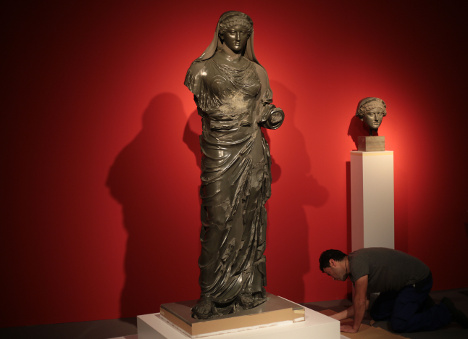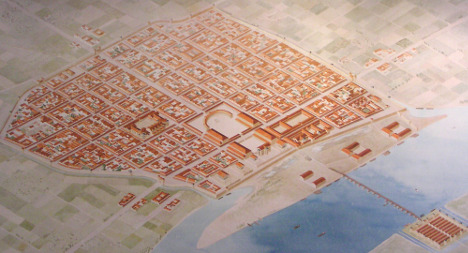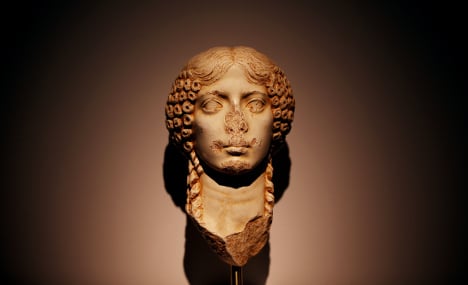“I've not written a biography of Agrippina,” author Mario Kramp told Germany news agency DPA.
Instead, he's been looking into the legacy and myth of this infamous Roman empress. And his conclusion?
“Since the Middle Ages, most of Europe has agreed that Agrippina was a monster,” he said.
But in Cologne, it's a different story.
“Here, she's regarded as the founder of the city – so she can't be labelled a monster.”
Kramp's book “Cologne and its Agrippina” was released on November 19th – and is just one way the city is celebrating the 2000th birthday of its controversial founder.
But who exactly was Agrippina – and why does she continue to divide opinion, 2,000 years after her birth?

A larger-than-life statue of Agrippina is now on show in the Romano-Germanic Museum. Photo: DPA
A suspicious love life
Agrippina was born in AD 15, in the military stronghold that would later become Cologne.
But just a few months later, her father – a soldier – was deployed to Syria.
Agrippina would never see the city of her birth again. Instead, she grew up in Rome as a beautiful and influential young woman.
Her first marriage to her second cousin, Domitius, produced a son, Lucius Domitius Ahenobarbus – later known as Nero.
When her husband died from edema in AD 40, Agrippina married again.
But in AD 47 her second husband also died, leaving his estate to Nero – and causing rumours that Agrippa had poisoned him to inherit his wealth.
Becoming a widow for the second time had definitely left Agrippa wealthy, while her tragic circumstances also earned her some sympathy.
However, her scheming love life was far from over.
The most powerful woman in the Empire
Agrippina's uncle Claudius was now the Emperor of Rome.
She was 33, he was 58 – and marriages between niece and uncle were deemed incestuous and immoral.
But that didn't stop Agrippina seducing her uncle, and on New Year's Day of AD 49, the pair married.
Claudius later adopted Nero.
Agrippina wasn't about to be sidelined, however. As wife of the emperor, she wanted to rule alongside Claudius – and she soon became the most powerful woman in the Roman Empire.
“Everyone obeyed this woman,” historical writer Tacitus wrote. “She held the reins tightly, like a man.”
One thing Agrippina was keen to do was rename that outpost in the north of the empire where she had been born.
“Colonia Claudia Ara Agrippinensis:” meant, in rough translation “A city under Roman law, in the region of one of the altars consecrated by the emperor, founded by Claudius through the initiative of Agrippina.”
Understandably, this was shortened to Colonia, which over the years, morphed into Köln – the German name for Cologne.

How the Roman city of Colonia may have looked. Photo: Nicolas von Kospoth / Wikimedia Commons
Generations of murder
But by AD 54, Claudius regretted marrying Agrippa and adopting Nero.
He began to favour Britannicus – the son he had pushed aside when he had fallen under the spell of Agrippina and Nero, and who earned his name after his conquest of Britain.
When Agrippina realised Claudius wanted Britannicus to take the throne rather than Nero, she was incensed.
According to ancient sources, she fed her husband a plate of deadly mushrooms at a banquet.
With Claudius dead, Nero took the throne.
However, Agrippina's only son must have learned a few lessons from his murderous mother.
Over the next few years, Nero gradually took stripped Agrippina of her honours and powers, including her bodyguards, and her residence in the imperial castle.
Eventually, Nero had his own mother murdered.
Accounts of Agrippina's death are varied – but many suggest that Nero fashioned a kind of self-sinking boat, with the intention of drowning his mother.
When Agrippina survived the shipwreck, Nero allegedly sent assassins to kill her.
The news of Agrippina's death reached Cologne in early AD 59.
Just nine years after being raised to the status of a city, Cologne had lost its patroness.
“Mother, maiden and monster”
She might be allegedly responsible for some ten murders over the years, but Agrippina is still held in high regard in Cologne.
With both an insurance company and a brand of cigars named after her – and a ceremonial spot as the “young maiden” at the annual Karneval – Agrippina's name is far from forgotten in the Rhineland city.

The Karneval's “Jungfrau,” or maiden (left) is based on Agrippina – and traditionally played by a man. Photo: DPA
“It's one of Cologne's phenomena,” Kramp laughed.
“A female founder of a 2,000-year-old German city, who is mother, maiden and monster all at the same time!”
The Agrippina exhibition at the Romano-Germanic museum is running until March 29th, 2016.
“It's a great honour for us,” museum director Marcus Trier told DPA.



 Please whitelist us to continue reading.
Please whitelist us to continue reading.
Member comments